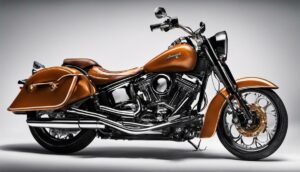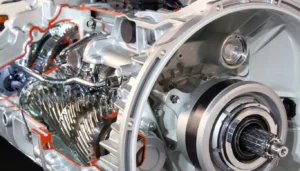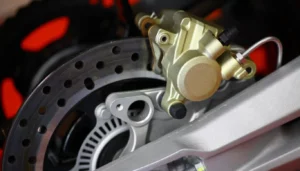Motorcycle forks play an integral role in the overall operation of your bike. These parts not only support the front wheel and handlebar but also absorb shocks and help maintain balance. When forks become bent, they can significantly affect your bike’s performance and safety.
Bent forks can be the result of various situations such as severe impacts, accidents, or even simple wear and tear over time. Potholes, bumps, and rough terrains are common culprits that can lead to fork bending.
Recognizing the signs of fork damage is essential for timely repair. Some common signs include difficulty in steering, vibrations in the handlebar, uneven tire wear, and a noticeable lean in your motorcycle.
Importance of Motorcycle Forks
Motorcycle forks have stanchions, sliders, springs and dampers. Bike stability and handling depend on each component.
Telescopic, inverted, and leading-link motorcycle forks exist. Each has unique construction, benefits, and drawbacks.
Motorcycle forks help riders balance, handle and absorb shocks. They make navigating different terrains easy and safe.
Functionality of Motorcycle Forks
The front suspension system’s forks are crucial to a motorcycle’s operation. Understanding these functions can help you appreciate the importance of fork maintenance and fixing bends quickly.
- Shock Absorption: Motorcycle forks primarily absorb road shocks. The fork springs compress and expand to absorb shock as you ride over bumps. This makes rough terrain smooth and comfortable.
- Supporting the Front Wheel: Motorcycle forks primarily absorb road shocks. The fork springs compress and expand to absorb shock as you ride over bumps. This makes rough terrain smooth and comfortable.
- Steering and Stability: Motorcycle forks pivot the handlebars to steer. The bike’s stability and handling at different speeds depend on the forks’ length and rake angle.
- Braking System Housing: Many motorcycles have fork-mounted front disc brakes. Braking forces require a sturdy fork. Fork damage may affect braking performance.
- Suspension Damping: Forks absorb shocks and control suspension rebound after compression. High-speed riding and cornering require this damping effect to maintain bike control. Adjustable damping lets riders customise their suspension to their riding style and conditions.
- Aesthetic Appeal: Motorcycle forks enhance the bike’s appearance. Traditional telescopic, inverted and Springer-style forks can drastically change a motorcycle’s appearance.
Motorcycle forks enhance performance, safety, and aesthetics. Thus, they must be maintained and promptly repaired if they bend.
Impact of Bent Forks on Motorcycle Performance
Bent forks make bike steering difficult. This increases accident risk, especially when riding fast or in traffic.
Bent forks absorb shocks poorly, making rides uncomfortable. Instabilities and poor handling can also compromise safety.
Bent forks cause uneven tyre wear. This can cause tyre failure during rides and frequent tyre replacements.
DIY vs. Professional Repair: Making the Right Choice
Fixing bent forks starts with assessing damage. DIY methods can fix minor bends, but severe damage requires professional repair.
DIY repairs may be cost-effective if the bend is minor and you have motorcycle maintenance experience. To avoid damage, you need the right tools and a detailed guide.
Professional help is safer for major bends or if you lack the tools or experience. Professional mechanics can safely repair forks.
Essential Tools for Fixing Bent Motorcycle Forks
Fixing bent motorcycle forks requires special tools. The right tools make the job easier and safer. Essential tools include:
- Wrenches: Fork disassembly and reassembly require wrenches to loosen and tighten nuts and bolts. A wrench set with multiple sizes will be useful.
- Fork Straightener: This fixes minor fork bends. It evenly presses the forks to straighten them without damaging them.
- Hydraulic Press: Hydraulic presses are needed for severe bends. This tool straightens bent areas by applying controlled, significant force.
- Level: Checking fork straightness during and after repair requires a level. Long levels are more accurate.
- Micrometer or Caliper: To ensure uniformity, measure fork diameters before and after straightening with a micrometre or calliper.
- Safety Gear: Safety gear is crucial. Safety glasses, gloves, and sturdy shoes are necessary during repairs.
Choosing Quality Tools
Choose high-quality tools. Quality tools improve precision, durability, and usability. They may cost more upfront, but they can save you money by preventing motorbike damage from poor repairs.
Understanding the Role of Each Tool
Each tool in your kit plays a unique role in the repair process:
- Wrenches are used for removing and reinstalling various components.
- A fork straightener is designed to fix minor bends.
- A hydraulic press is necessary for correcting more severe bends.
- A level is used for checking the straightness of the forks.
- A micrometer or caliper is used for measuring accuracy.
- Safety gear protects you from potential injuries during the repair process.
By understanding each tool’s role and using them correctly, you can efficiently and safely repair bent motorcycle forks.
Step-by-Step Guide to Fixing Bent Forks
1. Preparing Your Work Space
Prepare your workspace before starting repairs. Maintain a clean, well-lit, and ventilated workspace. Your motorcycle and tools should fit. Remove clutter to avoid tripping or losing tools. Make your tools easily accessible.
2. Safety Precautions
Motorcycle repair requires safety. Wear gloves and safety glasses to prevent injuries. Handle heavy components and tools carefully, and support your motorcycle to avoid tipping.
3. Disassembling the Forks
Motorcycle disassembly begins with removing the front wheel. After securing the motorcycle, loosen the axle nut with a wrench and slide the axle out to remove the wheel. Loosen the upper and lower triple clamp bolts. Slide each fork out from the top once loose. To simplify reassembly, note spacer and washer order and orientation.
4. Assessing the Degree of Damage
Check the forks for damage after disassembling. Visible bends, dents, and cracks. A bent fork has a visible bend. Professional repair or replacement is recommended for extensive damage or cracked forks.
5. Methods of Straightening the Forks
You can straighten forks if the damage is minor. Carefully straighten the fork with a fork straightener. A screw mechanism gently bends the fork with this tool.
Hydraulic presses are needed for severe bends. Place the bent fork in the press, apply pressure slowly, and constantly check the alignment with a level to avoid overcorrecting or causing additional bends.
Be patient and attentive. If you’re unsure, get help.
6. Checking Your Work
Verify your fork straightening afterward. Check for any remaining bends, dents, or new damage from the repair. Straighten with a straight edge or long level. Reassemble if everything looks good.
7. Reassembling the Forks
Reassemble now. Return the forks to the triple clamps in the same position. Reinstall spacers and washers in the correct order and orientation. Tighten triple clamp bolts to recommended torque.
Finally, slide the axle back into place and tighten the axle nut. After reassembling everything, test your motorbike at low speed in a safe place.
Remember, while DIY repair can be cost-effective and satisfying, it’s essential to know your limits. Always prioritize safety and seek professional help when needed.
Aftercare and Maintenance Post Repair
Maintenance extends motorcycle fork life. Checking, cleaning, lubricating, and replacing worn parts are included.
Avoid potholes and obstacles to prevent fork bending. Maintenance and quality parts can also prevent damage.
Check your forks often for damage. To prevent damage or unsafe riding, address anything unusual immediately.
Frequently Asked Questions (FAQs)
Careful riding and maintenance can reduce the risk of bent forks.
Motorcycle maintenance should include fork damage checks. Monthly checks are usually sufficient, but riding habits and conditions may require more frequent checks.
For serious bends, specialised tools or professional help may be needed.
Bending motorcycle forks is dangerous. It causes handling issues, tyre wear, and accidents.
Depending on the damage and whether you do it yourself or hire a professional, fixing bent forks can be expensive. Compare bike safety and performance to cost.
Yes, bent forks can cause uneven tyre wear and stress other motorcycle parts, potentially causing damage.
Conclusion
Summarize the importance of motorcycle forks, how bent forks affect performance, DIY versus professional repair, how to fix bent forks, and aftercare and maintenance.
Encourage safe riding, including regular maintenance checks, careful navigation to avoid damage, and prompt fork repair.
End the article by emphasising the rider’s role in motorcycle maintenance for safe and enjoyable rides.






